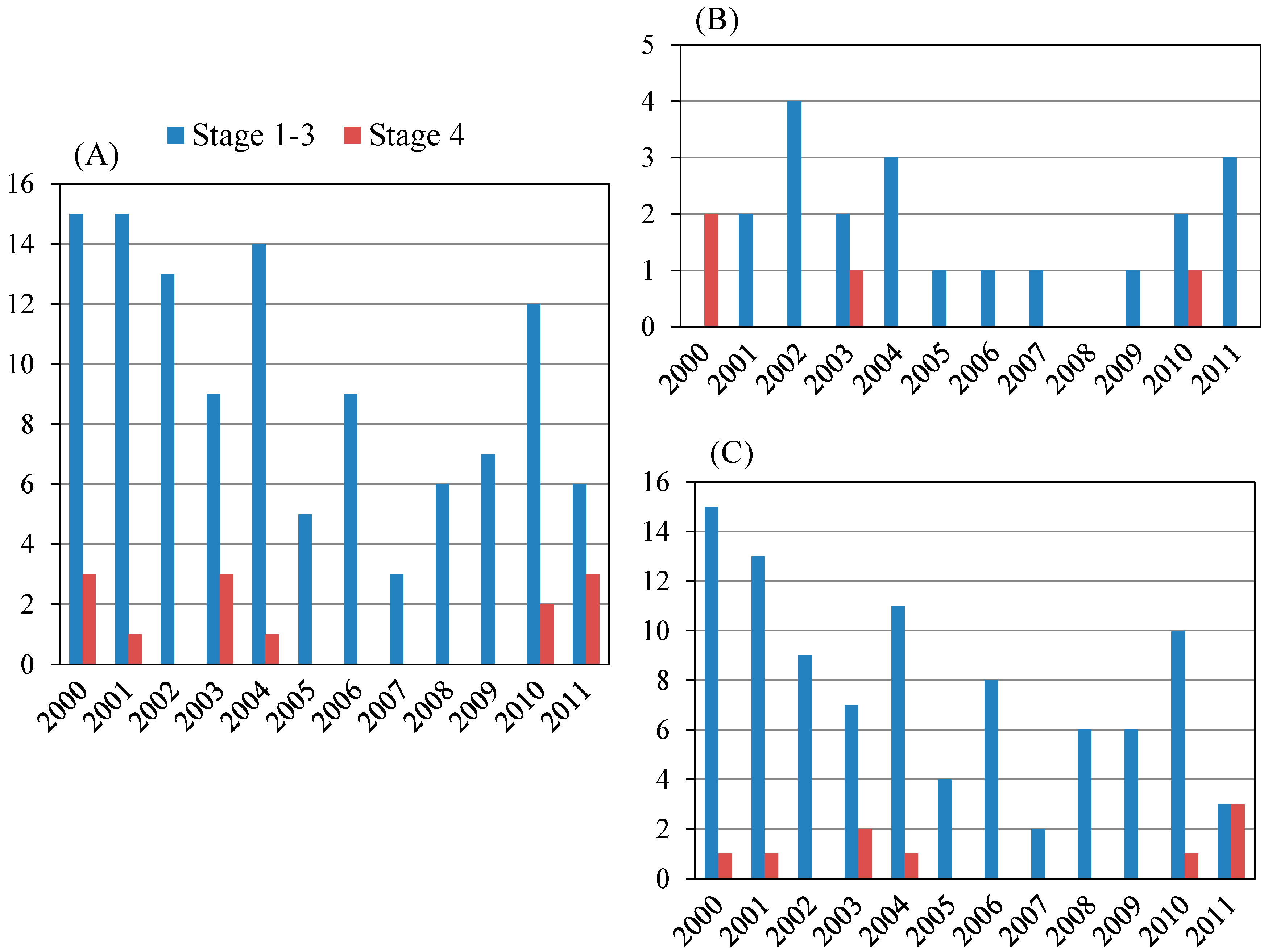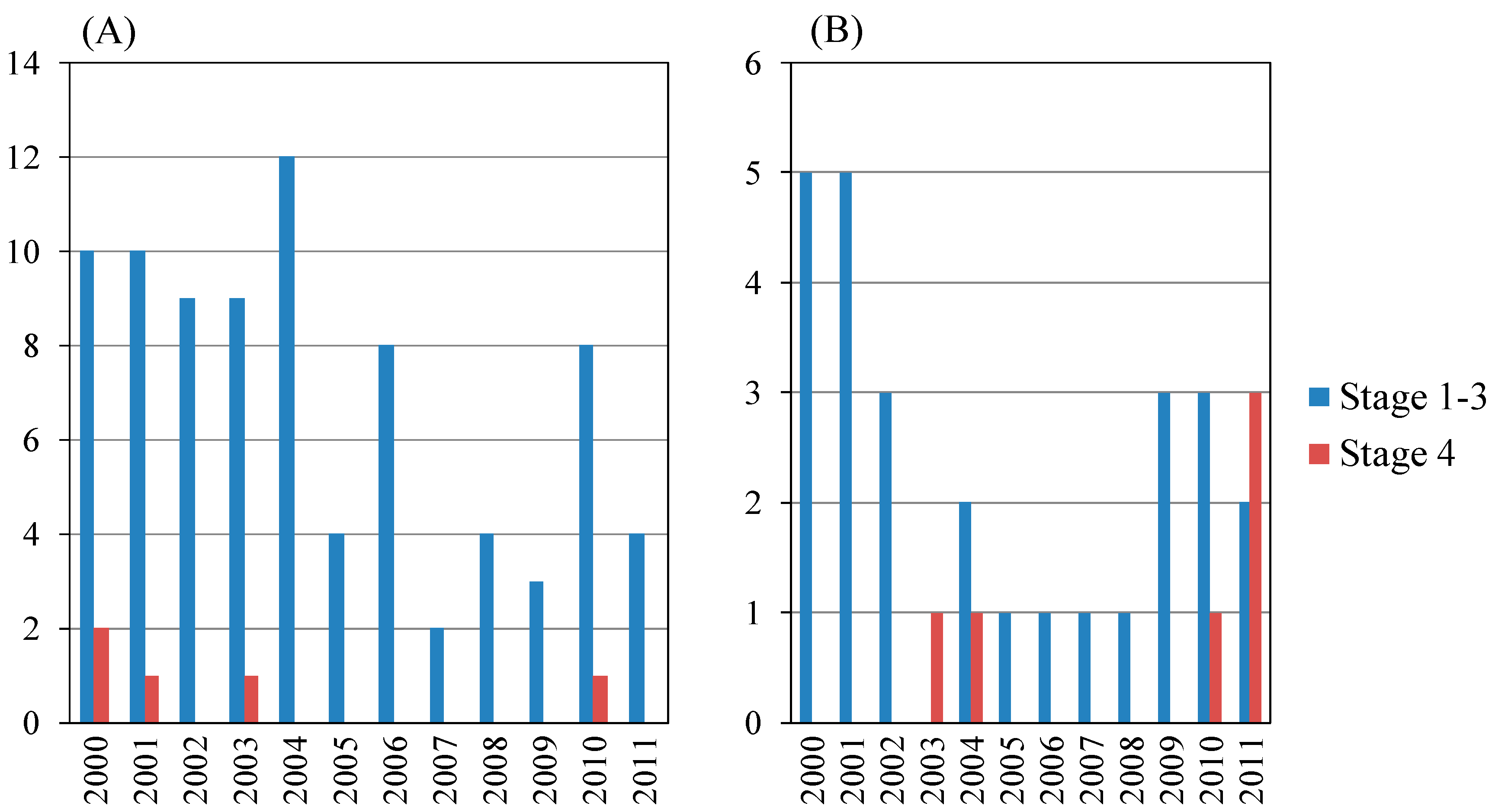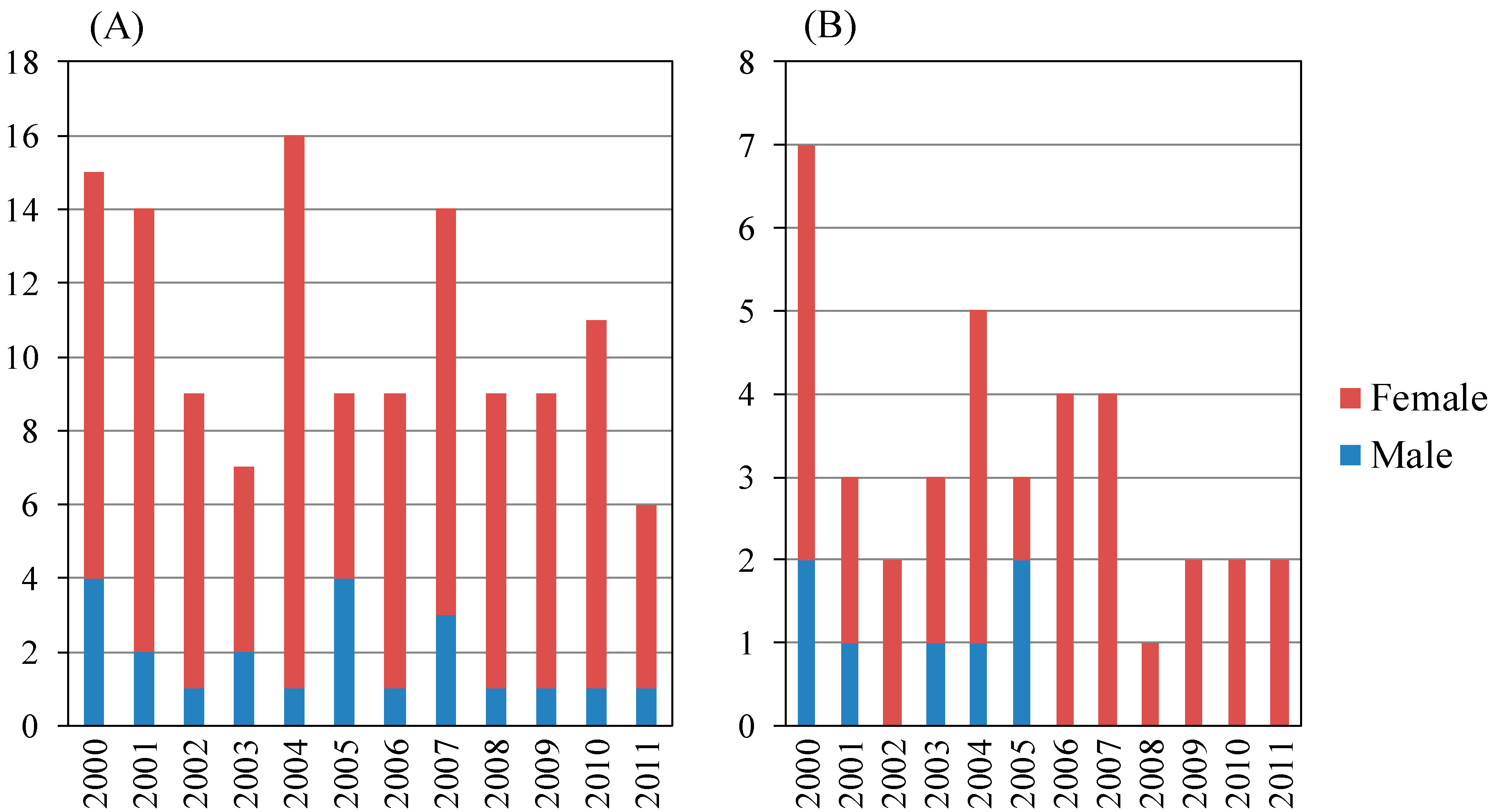Impact of Aging on Liver Histological Findings of Autoimmune Liver Diseases
Abstract
:1. Introduction
2. Experimental Section
2.1. Research Subjects
2.2. Liver Biopsy
2.3. Evaluation of Biopsy Samples
2.4. Statistical Analysis
3. Results
3.1. Patient Characteristics
| Total Patients (n = 259) | PBC (n = 131) | AIH (n = 128) | p-values | |
|---|---|---|---|---|
| Age (years) | 56.8 ± 12.5 | 57.2 ± 10.7 | 56.5 ± 14.2 | N.S. |
| Older Patients (≥65 years) | 71 | 33 | 38 | N.S. |
| Gender (male/female) | 46/213 | 24/107 | 22/106 | N.S. |
| Histopathological findings | ||||
| Staging of Fibrosis (F1/F2/F3/F4) | - | - | 37/32/19/13 | - |
| Grading of Activity (A1/A2/A3) | - | - | 22/25/54 | - |
| Scheuer Stage (1/2/3/4) | - | 42/54/18/13 | - | - |
3.2. Annual Changes in the Number of PBC Patients with Liver Biopsy
3.3. Older PBC Patients Tended to Have Advanced Fibrosis


| (A) | ||
| Year of Diagnosis | Age at Diagnosis (years) | Gender |
| 2000 | 49 | Male |
| 2000 | 57 | Female |
| 2001 | 42 | Female |
| 2003 | 60 | Female |
| 2010 | 59 | Male |
| 2003 | 80 | Female |
| 2004 | 68 | Female |
| 2010 | 70 | Female |
| 2011 | 73 | Female |
| 2011 | 78 | Female |
| 2011 | 80 | Female |
| (B) | ||
| Year of diagnosis | Age at diagnosis (years) | Gender |
| 2001 | 58 | Female |
| 2002 | 45 | Female |
| 2004 | 62 | Female |
| 2004 | 61 | Female |
| 2006 | 36 | Male |
| 2011 | 58 | Female |
| 2000 | 67 | Male |
| 2004 | 68 | Female |
| 2005 | 72 | Male |
| 2005 | 74 | Male |
| 2009 | 70 | Female |
| 2009 | 70 | Female |
3.4. Annual Changes in the Number of AIH Patients with Liver Biopsy
| (A) | ||||||
| Total Patients (n = 101) | Male (n = 18) | Female (n = 83) | ||||
| Year | F1-F3 | F4 | F1-F3 | F4 | F1-F3 | F4 |
| 2000 | 13 | 1 | 3 | 1 | 10 | 0 |
| 2001 | 11 | 1 | 2 | 0 | 9 | 1 |
| 2002 | 8 | 1 | 1 | 0 | 7 | 1 |
| 2003 | 7 | 0 | 2 | 0 | 5 | 0 |
| 2004 | 9 | 4 | 1 | 0 | 8 | 4 |
| 2005 | 7 | 2 | 2 | 2 | 5 | 0 |
| 2006 | 7 | 1 | 0 | 1 | 7 | 0 |
| 2007 | 7 | 0 | 0 | 0 | 7 | 0 |
| 2008 | 5 | 0 | 1 | 0 | 4 | 0 |
| 2009 | 5 | 2 | 1 | 0 | 4 | 2 |
| 2010 | 4 | 0 | 0 | 0 | 4 | 0 |
| 2011 | 5 | 1 | 1 | 0 | 4 | 1 |
| Total | 88 | 13 | 14 | 4 | 74 | 9 |
| (B) | ||||||
| Total patients (n = 101) | Male (n = 18) | Female (n = 83) | ||||
| Year | A1 | A2 or A3 | A1 | A2 or A3 | A1 | A2 or A3 |
| 2000 | 3 | 11 | 0 | 4 | 3 | 7 |
| 2001 | 3 | 9 | 0 | 2 | 3 | 7 |
| 2002 | 1 | 8 | 0 | 1 | 1 | 7 |
| 2003 | 1 | 6 | 0 | 2 | 1 | 4 |
| 2004 | 3 | 10 | 0 | 1 | 3 | 9 |
| 2005 | 1 | 8 | 0 | 4 | 1 | 4 |
| 2006 | 1 | 7 | 0 | 1 | 1 | 6 |
| 2007 | 1 | 6 | 0 | 0 | 1 | 6 |
| 2008 | 3 | 2 | 0 | 1 | 3 | 1 |
| 2009 | 2 | 5 | 0 | 1 | 2 | 4 |
| 2010 | 2 | 2 | 0 | 0 | 2 | 2 |
| 2011 | 1 | 5 | 0 | 1 | 1 | 4 |
| Total | 22 | 79 | 0 | 18 | 22 | 61 |
3.5. Clinical Features of Older Patients with AIH

| (A) | ||||
| Age < 65 (years) | Age ≥ 65 (years) | |||
| Year | F1-F3 | F4 | F1-F3 | F4 |
| 2000 | 7 | 0 | 6 | 1 |
| 2001 | 8 | 1 | 3 | 0 |
| 2002 | 6 | 1 | 2 | 0 |
| 2003 | 4 | 0 | 3 | 0 |
| 2004 | 5 | 2 | 4 | 1 |
| 2005 | 6 | 0 | 1 | 2 |
| 2006 | 3 | 1 | 4 | 0 |
| 2007 | 2 | 0 | 3 | 0 |
| 2008 | 2 | 0 | 1 | 0 |
| 2009 | 2 | 0 | 0 | 2 |
| 2010 | 3 | 0 | 1 | 0 |
| 2011 | 3 | 1 | 2 | 0 |
| Total | 51 | 6 | 30 | 6 |
| (B) | ||||
| Age < 65 (years) | Age ≥ 65 (years) | |||
| Year | A1 | A2 or A3 | A1 | A2 or A3 |
| 2000 | 3 | 4 | 0 | 7 |
| 2001 | 2 | 7 | 1 | 2 |
| 2002 | 1 | 6 | 0 | 2 |
| 2003 | 0 | 4 | 1 | 2 |
| 2004 | 3 | 4 | 0 | 5 |
| 2005 | 1 | 5 | 0 | 3 |
| 2006 | 1 | 3 | 0 | 4 |
| 2007 | 0 | 2 | 1 | 2 |
| 2008 | 2 | 0 | 1 | 0 |
| 2009 | 1 | 1 | 1 | 1 |
| 2010 | 1 | 2 | 1 | 0 |
| 2011 | 1 | 3 | 0 | 2 |
| Total | 16 | 41 | 6 | 30 |
4. Discussion
Acknowledgments
Author Contributions
Conflicts of Interest
References
- Imam, M.H.; Lindor, K.D. The natural history of primary biliary cirrhosis. Semin. Liver Dis. 2014, 34, 329–333. [Google Scholar] [CrossRef] [PubMed]
- Kim, W.R.; Lindor, K.D.; Locke, G.R., 3rd; Therneau, T.M.; Homburger, H.A.; Batts, K.P.; Yawn, B.P.; Petz, J.L.; Melton, L.J., 3rd; Dickson, E.R. Epidemiology and natural history of primary biliary cirrhosis in a US community. Gastroenterology 2000, 119, 1631–1636. [Google Scholar] [PubMed]
- James, O.F.; Bhopal, R.; Howel, D.; Gray, J.; Burt, A.D.; Metcalf, J.V. Primary biliary cirrhosis once rare, now common in the United Kingdom? Hepatology 1999, 30, 390–394. [Google Scholar] [CrossRef] [PubMed]
- Nakano, T.; Inoue, K.; Hirohara, J.; Arita, S.; Higuchi, K.; Omata, M.; Toda, G. Long-term prognosis of primary biliary cirrhosis (PBC) in Japan and analysis of the factors of stage progression in asymptomatic PBC (a-PBC). Hepatol. Res. 2002, 22, 250–260. [Google Scholar] [CrossRef] [PubMed]
- Kanda, T.; Yokosuka, O.; Imazeki, F.; Hirasawa, Y.; Ikeuchi, T.; Mikata, R.; Zhang, K.Y.; Kurihara, T.; Arai, M.; Fukai, K.; et al. Body mass index in Japanese patients with autoimmune liver disease: Overweight patients with primary biliary cirrhosis tend to be asymptomatic. Hepatogastroenterology 2007, 54, 1758–1760. [Google Scholar] [PubMed]
- Nakamura, M. Clinical significance of autoantibodies in primary biliary cirrhosis. Semin. Liver Dis. 2014, 34, 334–340. [Google Scholar] [CrossRef] [PubMed]
- Poupon, R. Evidence-based treatment of primary biliary cirrhosis. Dig. Dis. 2014, 32, 626–630. [Google Scholar] [CrossRef] [PubMed]
- Kanda, T.; Yokosuka, O.; Imazeki, F.; Saisho, H. Bezafibrate treatment: A new medical approach for PBC patients? J. Gastroenterol. 2003, 38, 573–578. [Google Scholar]
- Strassburg, C.P.; Manns, M.P. Treatment of autoimmune hepatitis. Semin. Liver Dis. 2009, 29, 273–285. [Google Scholar] [CrossRef] [PubMed]
- Manns, M.P.; Czaja, A.J.; Gorham, J.D.; Krawitt, E.L.; Mieli-Vergani, G.; Vergani, D.; Vierling, J.M. Diagnosis and management of autoimmune hepatitis. Hepatology 2010, 51, 2193–2213. [Google Scholar] [CrossRef] [PubMed]
- Kanda, T.; Yokosuka, O.; Hirasawa, Y.; Imazeki, F.; Nagao, K.; Saisho, H. Occurrence of autoimmune hepatitis during the course of primary biliary cirrhosis: Report of two cases. Dig. Dis. Sci. 2006, 51, 45–46. [Google Scholar] [CrossRef] [PubMed]
- Kanda, T.; Yokosuka, O.; Hirasawa, Y.; Imazeki, F.; Nagao, K.; Suzuki, Y.; Saisho, H. Acute-onset autoimmune hepatitis resembling acute hepatitis: A case report and review of reported cases. Hepatogastroenterology 2005, 52, 1233–1235. [Google Scholar] [PubMed]
- Abe, M.; Onji, M.; Kawai-Ninomiya, K.; Michikata, K.; Matsuura, B.; Hiasa, Y.; Horiike, N. Clinicopathologic features of the severe form of acute type 1 autoimmune hepatitis. Clin. Gastroenterol. Hepatol. 2007, 5, 255–258. [Google Scholar] [CrossRef] [PubMed]
- Miyake, Y.; Yamamoto, K. Current status of autoimmune hepatitis in Japan. Acta Med. Okayama 2008, 62, 217–226. [Google Scholar] [PubMed]
- Boberg, K.M. Prevalence and epidemiology of autoimmune hepatitis. Clin. Liver Dis. 2002, 6, 635–647. [Google Scholar] [CrossRef] [PubMed]
- Ngu, J.H.; Bechly, K.; Chapman, B.A.; Burt, M.J.; Barclay, M.L.; Gearry, R.B.; Stedman, C.A. Population-based epidemiology study of autoimmune hepatitis: A disease of older women? J. Gastroenterol. Hepatol. 2010, 25, 1681–1686. [Google Scholar] [CrossRef] [PubMed]
- Toda, G.; Zeniya, M.; Watanabe, F.; Imawari, M.; Kiyosawa, K.; Nishioka, M.; Tsuji, T.; Omata, M. Present status of autoimmune hepatitis in Japan—Correlating the characteristics with international criteria in an area with a high rate of HCV infection. Japanese National Study Group of Autoimmune Hepatitis. J. Hepatol. 1997, 26, 1207–1212. [Google Scholar] [CrossRef] [PubMed]
- Yasui, S.; Fujiwara, K.; Yonemitsu, Y.; Oda, S.; Nakano, M.; Yokosuka, O. Clinicopathological features of severe and fulminant forms of autoimmune hepatitis. J. Gastroenterol. 2011, 46, 378–390. [Google Scholar] [CrossRef] [PubMed]
- Fujiwara, K.; Yasui, S.; Tawada, A.; Okitsu, K.; Yonemitsu, Y.; Chiba, T.; Arai, M.; Kanda, T.; Imazeki, F.; Nakano, M.; et al. Autoimmune fulminant liver failure in adults: Experience in a Japanese center. Hepatol. Res. 2011, 41, 133–141. [Google Scholar] [CrossRef] [PubMed]
- Rockey, D.C.; Caldwell, S.H.; Goodman, Z.D.; Nelson, R.C.; Smith, A.D. American Association for Study of Liver Diseases. Liver biopsy. Hepatology 2009, 49, 1017–1044. [Google Scholar] [CrossRef] [PubMed]
- Kanda, T.; Nakamoto, S.; Yasui, S.; Nakamura, M.; Miyamura, T.; Wu, S.; Jiang, X.; Arai, M.; Imazeki, F.; Yokosuka, O. Occurrence and Recurrence of Hepatocellular Carcinoma Were Not Rare Events during Phlebotomy in Older Hepatitis C Virus-Infected Patients. Case Rep. Oncol. 2014, 7, 288–296. [Google Scholar] [CrossRef] [PubMed]
- Nishikawa, H.; Kita, R.; Kimura, T.; Ohara, Y.; Takeda, H.; Sakamoto, A.; Saito, S.; Nishijima, N.; Nasu, A.; Komekado, H.; et al. Transcatheter arterial chemoembolization for intermediate-stage hepatocellular carcinoma: Clinical outcome and safety in elderly patients. J. Cancer 2014, 5, 590–597. [Google Scholar] [CrossRef] [PubMed]
- Scheuer, P. Primary biliary cirrhosis. Proc. R. Soc. Med. 1967, 60, 1257–1260. [Google Scholar] [PubMed]
- Goodman, Z.D. Grading and staging systems for inflammation and fibrosis in chronic liver diseases. J. Hepatol. 2007, 47, 598–607. [Google Scholar] [CrossRef] [PubMed]
- Obara, N.; Ueno, Y.; Fukushima, K.; Nakagome, Y.; Kakazu, E.; Kimura, O.; Wakui, Y.; Kido, O.; Ninomiya, M.; Kogure, T.; et al. Transient elastography for measurement of liver stiffness measurement can detect early significant hepatic fibrosis in Japanese patients with viral and nonviral liver diseases. J. Gastroenterol. 2008, 43, 720–728. [Google Scholar] [CrossRef] [PubMed]
- Friedrich-Rust, M.; Rosenberg, W.; Parkes, J.; Herrmann, E.; Zeuzem, S.; Sarrazin, C. Comparison of ELF, FibroTest and FibroScan for the non-invasive assessment of liver fibrosis. BMC Gastroenterol. 2010, 10, 103. [Google Scholar] [CrossRef] [PubMed]
- Tawada, A.; Maruyama, H.; Kamezaki, H.; Shimada, T.; Ishibashi, H.; Takahashi, M.; Kanda, T.; Fujiwara, K.; Imazeki, F.; Yokosuka, O. Magnitude of contrast-enhanced ultrasonography as a noninvasive predictor for hepatic fibrosis: Comparison with liver stiffness measurement and serum-based models. Hepatol. Int. 2013, 7, 749–757. [Google Scholar] [CrossRef]
- Japan Intractable Diseases Information Center. Available online: http://www.nanbyou.or.jp/entry/93 (accessed on 17 August 2014).
- Harada, K.; Hirohara, J.; Ueno, Y.; Nakano, T.; Kakuda, Y.; Tsubouchi, H.; Ichida, T.; Nakanuma, Y. Incidence of and risk factors for hepatocellular carcinoma in primary biliary cirrhosis: National data from Japan. Hepatology 2013, 57, 1942–1949. [Google Scholar] [CrossRef] [PubMed]
- Floreani, A.; Liberal, R.; Vergani, D.; Mieli-Vergani, G. Autoimmune hepatitis: Contrasts and comparisons in children and adults—A comprehensive review. J. Autoimmun. 2013, 46, 7–16. [Google Scholar] [CrossRef] [PubMed]
- Miyake, T.; Miyaoka, H.; Abe, M.; Furukawa, S.; Shigematsu, S.; Furukawa, E.; Ikeda, R.; Okita, S.; Okada, T.; Yoshida, O.; et al. Clinical characteristics of autoimmune hepatitis in older aged patients. Hepatol. Res. 2006, 36, 139–142. [Google Scholar] [CrossRef] [PubMed]
- Stimac, D.; Milić, S.; Dintinjana, R.D.; Kovac, D.; Ristić, S. Androgenic/Anabolic steroid-induced toxic hepatitis. J. Clin. Gastroenterol. 2002, 35, 350–352. [Google Scholar] [CrossRef] [PubMed]
- Jiang, X.; Kanda, T.; Nakamoto, S.; Miyamura, T.; Wu, S.; Yokosuka, O. Involvement of androgen receptor and glucose-regulated protein 78 kDa in human hepatocarcinogenesis. Exp. Cell Res. 2014, 323, 326–336. [Google Scholar] [CrossRef] [PubMed]
- Kanda, T.; Jiang, X.; Yokosuka, O. Androgen receptor signaling in hepatocellular carcinoma and pancreatic cancers. World J. Gastroenterol. 2014, 20, 9229–9236. [Google Scholar] [PubMed]
- Alvarez, F.; Berg, P.A.; Bianchi, F.B.; Bianchi, L.; Burroughs, A.K.; Cancado, E.L.; Chapman, R.W.; Cooksley, W.G.; Czaja, A.J.; Desmet, V.J.; et al. International Autoimmune Hepatitis Group Report: Review of criteria for diagnosis of autoimmune hepatitis. J. Hepatol. 1999, 31, 929–938. [Google Scholar] [CrossRef] [PubMed]
- Hennes, E.M.; Zeniya, M.; Czaja, A.J.; Parés, A.; Dalekos, G.N.; Krawitt, E.L.; Bittencourt, P.L.; Porta, G.; Boberg, K.M.; Hofer, H.; et al. Simplified criteria for the diagnosis of autoimmune hepatitis. Hepatology 2008, 48, 169–176. [Google Scholar] [CrossRef] [PubMed]
- Ohira, H.; Abe, K.; Takahashi, A.; Zeniya, M.; Ichida, T. Clinical features of hepatocellular carcinoma in patients with autoimmune hepatitis in Japan. J. Gastroenterol. 2013, 48, 109–114. [Google Scholar] [CrossRef] [PubMed]
- Hayashi, M.; Kanda, T.; Nakamura, M.; Miyamura, T.; Yasui, S.; Nakamoto, S.; Wu, S.; Arai, M.; Imazeki, F.; Yokosuka, O. Acute liver injury in a patient with alcohol dependence: A case resembling autoimmune hepatitis or drug-induced liver injury. Case Rep. Gastroenterol. 2014, 8, 129–133. [Google Scholar] [CrossRef] [PubMed]
- Donaldson, P.T.; Baragiotta, A.; Heneghan, M.A.; Floreani, A.; Venturi, C.; Underhill, J.A.; Jones, D.E.; James, O.F.; Bassendine, M.F. HLA class II alleles, genotypes, haplotypes, and amino acids in primary biliary cirrhosis: A large-scale study. Hepatology 2006, 44, 667–674. [Google Scholar] [CrossRef] [PubMed]
- Mells, G.F.; Floyd, J.A.; Morley, K.I.; Cordell, H.J.; Franklin, C.S.; Shin, S.Y.; Heneghan, M.A.; Neuberger, J.M.; Donaldson, P.T.; Day, D.B.; et al. Genome-wide association study identifies 12 new susceptibility loci for primary biliary cirrhosis. Nat. Genet. 2011, 43, 329–332. [Google Scholar] [CrossRef] [PubMed]
- Nakamura, M.; Nishida, N.; Kawashima, M.; Aiba, Y.; Tanaka, A.; Yasunami, M.; Nakamura, H.; Komori, A.; Nakamuta, M.; Zeniya, M.; et al. Genome-wide association study identifies TNFSF15 and POU2AF1 as susceptibility loci for primary biliary cirrhosis in the Japanese population. Am. J. Hum. Genet. 2012, 91, 721–728. [Google Scholar] [CrossRef] [PubMed]
- De Boer, Y.S.; van Gerven, N.M.; Zwiers, A.; Verwer, B.J.; van Hoek, B.; van Erpecum, K.J.; Beuers, U.; van Buuren, H.R.; Drenth, J.P.; den Ouden, J.W.; et al. Genome-wide association study identifies variants associated with autoimmune hepatitis type 1. Gastroenterology 2014, 147, 443–452. [Google Scholar] [CrossRef] [PubMed]
- Weinmann, A.; Sattler, T.; Unold, H.P.; Grambihler, A.; Teufel, A.; Koch, S.; Schuchmann, M.; Biesterfeld, S.; Wörns, M.A.; Galle, P.R.; et al. Predictive Scores in Primary Biliary Cirrhosis: A Retrospective Single Center Analysis of 204 Patients. J. Clin. Gastroenterol. 2014. [Google Scholar] [CrossRef]
- Loaeza-del-Castillo, A.; Paz-Pineda, F.; Oviedo-Cárdenas, E.; Sánchez-Avila, F.; Vargas-Vorácková, F. AST to platelet ratio index (APRI) for the noninvasive evaluation of liver fibrosis. Ann. Hepatol. 2008, 7, 350–357. [Google Scholar] [PubMed]
© 2014 by the authors; licensee MDPI, Basel, Switzerland. This article is an open access article distributed under the terms and conditions of the Creative Commons Attribution license (http://creativecommons.org/licenses/by/4.0/).
Share and Cite
Haga, Y.; Kanda, T.; Hagiwara, K.; Sasaki, R.; Nakamura, M.; Yasui, S.; Arai, M.; Jiang, X.; Wu, S.; Nakamoto, S.; et al. Impact of Aging on Liver Histological Findings of Autoimmune Liver Diseases. Diseases 2014, 2, 308-321. https://doi.org/10.3390/diseases2040308
Haga Y, Kanda T, Hagiwara K, Sasaki R, Nakamura M, Yasui S, Arai M, Jiang X, Wu S, Nakamoto S, et al. Impact of Aging on Liver Histological Findings of Autoimmune Liver Diseases. Diseases. 2014; 2(4):308-321. https://doi.org/10.3390/diseases2040308
Chicago/Turabian StyleHaga, Yuki, Tatsuo Kanda, Katsuhiro Hagiwara, Reina Sasaki, Masato Nakamura, Shin Yasui, Makoto Arai, Xia Jiang, Shuang Wu, Shingo Nakamoto, and et al. 2014. "Impact of Aging on Liver Histological Findings of Autoimmune Liver Diseases" Diseases 2, no. 4: 308-321. https://doi.org/10.3390/diseases2040308






